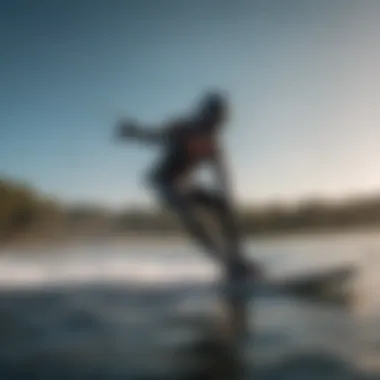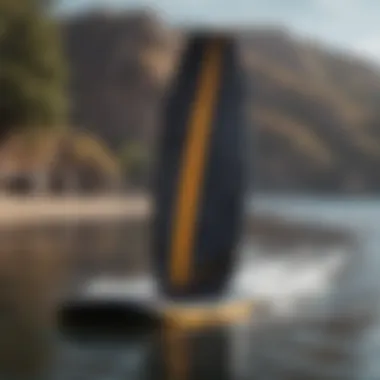Exploring the Future of Carbon Kiteboarding Technology


Intro
Carbon kiteboarding represents a synthesis of cutting-edge technology and dynamic outdoor adventure. As kiteboarding has evolved, carbon fiber has become a preferred material because of its light weight and incredible strength. This analysis delves into the technological advancements that have accompanied carbon kiteboarding, dissecting the underlying materials, performance benefits, and environmental implications of this thrilling sport.
The synthesis of technology and nature in carbon kiteboarding is not merely about performance. It touches on broader themes including sustainability and the community surrounding extreme sports. We will explore how kiteboarding culture is changing and what future trends may lie ahead, empowering enthusiasts not just to participate, but to do so with informed intention and respect for the environment.
Techniques and Tips
Skill Development
Developing proficiency in carbon kiteboarding requires dedication and practice. Beginner kiteboarders should focus on mastering the basics: controlling the kite, managing board speed, and maintaining balance. Small, consistent sessions are more effective for growth than infrequent long outings.
Practical Techniques
- Start in lighter winds to build confidence.
- Learn to perform basic maneuvers such as upwind riding and transitions before advancing to tricks.
- Always ensure your equipment is in top condition, as wear can lead to accidents.
Common Mistakes to Avoid
Avoid the following common pitfalls:
- Failing to check wind conditions and safety gear before heading out.
- Overestimating skill levels, especially in challenging weather.
- Neglecting the importance of a proper warm-up before sessions to prevent injuries.
Gear and Equipment
Essential Gear for Beginners
Every new kiteboarder should have:
- A suitable kite, typically a beginner-friendly model that has good stability.
- A properly fitting harness that offers comfort and support.
- A board designed for your weight and experience level, aiming for a wider outline for better stability.
Latest Innovations and Trends
Currently, carbon kiteboards are being optimized for both durability and performance. Innovations in design and materials result in boards that are not only lightweight but also provide superior responsiveness. Brands such as Naish and Slingshot are leading the charge in pushing these advancements.
Reviews and Comparisons
When evaluating carbon kiteboards, consider factors such as:
- Weight: Lighter boards are easier to maneuver but may sacrifice some durability.
- Shape: The outline affects floatation and speed.
- Construction: Look for robust designs which utilize advanced carbon layering techniques for improved strength-to-weight ratio.
Safety Measures
Essential Safety Gear
A well-equipped kiteboarder should prioritize these safety items:
- A helmet, to protect against falls.
- Impact vests that can cushion landing impacts.
- A quick release mechanism on the harness for emergencies.
Best Practices for Safe Participation
Professional advice recommends:
- Always kite with a buddy for safety.
- Hold a clear understanding of local regulations and guidelines to avoid hazardous areas.
- Regularly review your safety plan and know how to assess and respond to hazards quickly.
Injury Prevention and Management
Injuries can be managed by:
- Staying hydrated and warmed up.
- Engaging in strength training to build core and leg muscles.
- Knowing when to rest; overtraining can lead to fatigue and incidents.


Spotlights on Extreme Sports
Featured Sport of the Month
In this section, we highlight kiteboarding for its dynamic nature and the thrill it provides. The sport has transformed over recent decades, integrating wave riding, freestyle stunts, and deep water jumping into its fabric.
Profiles of Prominent Athletes
Kiteboarding champions, like Alex Pastor and Youri Zoon, exemplify the heights of performance and innovation in the sport. Their journeys not only inspire new athletes but also highlight the importance of advancement within kiteboarding technology.
"Kiteboarding combines fitness, focus, and fun—a unique blend of three elements that draws people to the sport." - An experienced veteran.
Foreword to Carbon Kiteboarding
Understanding carbon kiteboarding is essential for anyone involved in or interested in extreme sports. This subject encapsulates not just the thrill of kiteboarding, but also the technological advancements that enhance the experience. As the sport grows, the materials used in its equipment have evolved significantly, leading to improvements not only in performance but also in safety and sustainability. Carbon fiber has emerged as a pivotal material in the design of kiteboards, allowing for a dynamic shift in how enthusiasts experience the water.
Definition of Kiteboarding
Kiteboarding is an exhilarating water sport that combines surfing with paragliding. Participants use a board and are propelled by a large, controllable kite. The rider stands on a board which can vary in size and shape. The kite is connected to the rider by a harness, allowing for maneuverability and control. The sport often takes place on oceans, lakes, or rivers and can accommodate conditions ranging from gentle breezes to high winds. This diversity in conditions enables a variety of styles, including freestyle, wave riding, and racing.
The Rise of Carbon Materials in Extreme Sports
The adoption of carbon materials in extreme sports reflects a broader trend toward lightweight and high-performance equipment. Carbon fiber, known for its exceptional strength-to-weight ratio, has increasingly influenced the design of kiteboards. Its introduction marks a pivotal moment in the evolution of the sport.
- Strength: Carbon kiteboards provide significant strength without added weight. This durability helps in withstanding the stresses of rough conditions.
- Weight Reduction: Less weight translates into better performance, especially in speed and maneuverability.
- Performance Enhancement: The unique properties of carbon fibers allow for designs that can respond rapidly to the rider's movements, enhancing the overall experience.
As manufacturers continue to experiment with carbon and other advanced materials, the future of kiteboarding looks promising. This trend represents not only a shift in the equipment used but also an awareness of the performance enhancement that such materials can offer.
Technological Advances in Kiteboard Design
The field of kiteboarding has seen significant evolutions, particularly in the realms of design and materials. Technological advancements have redefined how enthusiasts engage with the sport, amplifying performance and safety while catering to a variety of skill levels. It is crucial to understand these innovations as they shape user experiences and influence the broader kiteboarding culture. Given the integration of advanced materials like carbon fiber, the design of kiteboards is now more refined than ever, leading to impressive outcomes.
Material Properties of Carbon Fiber
Carbon fiber is a lightweight, high-strength material that has revolutionized kiteboard construction. Its attributes include excellent tensile strength and stiffness, along with a low weight-to-strength ratio. This combination allows for the creation of boards that not only perform better but are also easier to handle.
The properties of carbon fiber contribute significantly to the overall feel of a kiteboard. Boards made from this material provide enhanced responsiveness and control. Riders can make immediate adjustments while riding, resulting in improved handling in different water conditions. The following are specific key benefits of carbon fiber in kiteboard design:
- Lightweight construction which enhances maneuverability.
- Superior strength over traditional materials, reducing the risk of breakage.
- Improved energy transfer when sailing, providing a more dynamic ride.
Impact on Weight and Performance
The weight of a kiteboard dramatically influences its performance. Lighter boards, such as those crafted from carbon fiber, typically accelerate faster and allow for sharper turns. The reduction in weight leads to less drag in the water, allowing for a more exhilarating ride. Kiteboarders can harness the wind’s power more efficiently, gaining speed and enhancing overall performance.
This lightness plays a dual role. It not only lessens the effort required to maneuver the board but also contributes to increased agility. Riders can easily perform tricks and transitions without the encumbrance of heavy materials. Additionally, the balance achieved through optimized weight distribution further improves stability in various conditions. It enables riders to push their limits while feeling secure and confident.
Enhanced Durability and Lifespan
Durability is a paramount concern for any equipment designed for extreme sports, and kiteboards are no exception. Carbon fiber offers enhanced durability over traditional materials like fiberglass or wood. This durability translates into a longer lifespan for the board, making it a cost-effective option for riders.
Boards constructed with carbon fiber can withstand the rigors of frequent use, including harsh environmental conditions. This resilience minimizes the likelihood of damage from impacts, saltwater exposure, or UV degradation. Over time, this contributes to the overall value of the investment in a kiteboard.
"The integration of carbon fiber design allows kiteboarders to push their performance boundaries without compromising safety."
In summation, technological advancements in kiteboard design—particularly through the use of carbon fiber—have enabled a remarkable enhancement in performance characteristics. From the intrinsic material properties to their impact on weight and durability, every aspect combines to redefine what is possible in kiteboarding. The future of this sport is undoubtedly more thrilling and accessible as these advancements continue to evolve.
Performance Advantages of Carbon Kiteboards
Carbon kiteboards represent a significant leap in the performance dynamics of kiteboarding. They provide unique advantages that set them apart from traditional materials. Understanding these performance benefits is vital for both enthusiasts and professionals alike. In this section, we will discuss three primary performance advantages: acceleration and speed, flexibility and responsiveness, and stability in various conditions.


Acceleration and Speed
One of the standout features of carbon kiteboards is their ability to accelerate quickly. The lightweight nature of carbon fiber significantly reduces drag, enabling riders to reach thrilling speeds with less effort. This is essential for kiteboarding, where quick bursts of speed can enhance maneuverability and control. Significant speed increases allow kiteboarders to catch wind more effectively, leading to a more exhilarating ride on the water.
The construction of carbon kiteboards contributes to their overall rigidity. A stiffer board translates to better energy transfer from the kite to the rider. When a kiteboarder harnesses the wind, the energy is efficiently transferred due to the solid structure, giving an instantaneous acceleration unmatched by other materials.
Flexibility and Responsiveness
Flexibility is another key advantage of carbon kiteboards. While they offer a rigid structure that aids in speed, they also maintain a degree of flex that is critical for performance. This controlled flex allows for a better response to the rider's movements. A kiteboard that flexes appropriately absorbs the impact of waves and other disturbances, providing a smoother ride.
Moreover, this flexibility contributes to the overall responsiveness of the board. Kiteboarders can maneuver quickly and effectively while executing tricks or adjusting to changing conditions. In this sport, a quick reaction can mean the difference between a successful jump and a fall. Thus, the unique balance of stiffness and flex makes carbon kiteboards particularly suitable for high-performance riders.
Stability in Various Conditions
Stability is paramount in the unpredictable environment of kiteboarding. Carbon kiteboards excel in terms of stability across a range of conditions, from choppy waters to gusty winds. The design and shape of these boards play a crucial role in providing balance.
The low center of gravity that comes with the construction of carbon kiteboards contributes significantly to their stability. This feature allows riders to maintain control and confidence when faced with sudden changes in the water or wind conditions. Additionally, the composite materials used in carbon kiteboards aid in minimizing vibration, which enhances stability. Riders report higher comfort levels and reduced fatigue while using these boards, enabling longer sessions on the water.
Overall, the performance advantages of carbon kiteboards are compelling. From their quick acceleration and outstanding responsiveness to their stability across diverse conditions, these boards are revolutionizing the way the sport is approached. As advancements continue to pave the way, the impact of carbon materials on kiteboarding is sure to grow, offering even more opportunities for thrill-seekers and enthusiasts.
Environmental Considerations
The discussion surrounding carbon kiteboarding cannot ignore its environmental implications. As the sport evolves, it's vital to consider the impacts of material production and manufacturing methods on the planet. This section delves into the carbon footprint of production and sustainable practices in manufacturing, both of which are essential for the future of kiteboarding and the health of the environment.
Carbon Footprint of Production
The production of carbon fiber components used in kiteboards has a significant carbon footprint. It is important to understand the process involved in creating carbon fibers, which typically requires substantial energy. From the extraction of raw materials, through to processing and shaping, each step contributes to greenhouse gas emissions.
For instance, the production process often involves high temperatures and complex chemical treatments, both energy-intensive operations. The sources of energy used, such as coal or gas, can exacerbate the environmental impact. Consequently, as the demand for carbon kiteboarding gear increases, so does the need to scrutinize and improve these production methods to minimize their ecological consequences.
"Reducing carbon emissions in production processes is crucial for a sustainable future of extreme sports."
Sustainable Practices in Manufacturing
A shift towards sustainable manufacturing practices can help alleviate the negative effects associated with carbon kiteboarding. Several manufacturers are beginning to adopt greener practices, which include recycling materials and using renewable energy sources.
- Recycling and Reusing Materials: Many brands are looking into recycling off-cuts of carbon fiber and other materials. This reduces waste and lowers the demand for virgin materials, thus decreasing the overall carbon footprint of production.
- Renewable Energy Sources: Manufacturers are increasingly utilizing wind, solar, and other renewable energy forms. This transition not only minimizes emissions but can also lower production costs in the long term.
- Eco-friendly Resins: Assessment of resins used in kiteboard manufacturing is another area where companies can make important strides. Exploring bio-based alternatives has the potential to substantially reduce the carbon footprint.
In summary, the environmental considerations surrounding carbon kiteboarding highlight the critical need for balance between performance gains and ecological responsibility. Engaging with these issues thoughtfully may dictate the future trajectory of the sport.
Cultural Impact of Carbon Kiteboarding
The realm of carbon kiteboarding does not exist in isolation. It interweaves with various aspects of culture, reflecting values, community dynamics, and lifestyle choices of its participants. Understanding the cultural impact of carbon kiteboarding is essential to appreciate its role in the world of extreme sports.
Community and Lifestyle
The carbon kiteboarding community is characterized by a shared passion for adventure and the outdoors. Enthusiasts often engage in vibrant discussions about techniques, gear, and experiences on platforms such as Reddit and specialized forums. This active involvement fosters a sense of belonging and encourages newcomers to join the sport.
Daily life for many kiteboarders revolves around the pursuit of better conditions for riding. Beach locations like Maui and Cabarete are often hubs where athletes gather. These places are not just venues for sporting events; they become cultural melting pots, strengthening bonds among riders and creating friendships that last beyond the sport.
Social media plays a pivotal role in shaping the lifestyle of kiteboarders. Platforms like Facebook allow riders to share their adventures, showcase their skills, and build a connected community. Their posts inspire others and attract fresh participants, perpetuating the sport's popularity.
- Benefits of belonging to this community include:
- Sharing knowledge and tips for better performances.
- Opportunities for collaboration on eco-friendly initiatives.
- Access to events and competitions that celebrate the sport.
Events and Competitions
Events and competitions form a core aspect of the cultural significance surrounding carbon kiteboarding. They not only highlight skill and athleticism but also serve as platforms for global interaction among enthusiasts. High-profile events like the Red Bull King of the Air attract competitors from around the world, showcasing not just the sport, but also integrating it into a larger cultural narrative.


These competitions are often focal points for the community, providing exhilaration and camaraderie. They encourage participation from various skill levels and help promote up-and-coming talent. Such gatherings enrich local economies by attracting tourism and creating spaces for vendors and sponsors.
- Important aspects of kiteboarding events include:
- Competitive formats that highlight different disciplines.
- Skill demonstrations and workshops aimed at educating newcomers.
- Networking opportunities for brands, athletes, and fans alike.
Each event contributes uniquely to the narrative of carbon kiteboarding. By uniting diverse participants, they help shape perceptions about the sport and advocate for its future.
"The cultural dynamics of carbon kiteboarding bridge the gap between athletes and spectators, inspiring a postive outlook in the extreme sports community."
Safety Features and Considerations
Safety in kiteboarding is paramount. This sport inherently involves speed and height, which can present risks. It is essential to prioritize safety features to minimize these risks. In this section, we will discuss how design innovations can enhance safety in carbon kiteboarding, as well as the importance of user awareness and regular equipment checks.
Design Innovations Enhancing Safety
The introduction of advanced materials like carbon fiber has transformed kiteboard design significantly, contributing to improved safety features. Carbon kiteboards often integrate design elements intended to mitigate accidents and enhance rider control. Some of the key innovations include:
- Reinforced Structural Integrity: Carbon fiber provides superior strength-to-weight ratio, ensuring that the board remains rigid and minimizes the risk of breakage under stress.
- Optimized Shape: Manufacturers often design kiteboards with specific profiles that enhance stability. This reduces the chances of flipping over or unwanted movements during maneuvers.
- Integrated Safety Mechanisms: Newer designs include features like quick-release systems on harnesses to ensure users can disconnect from their kites rapidly in case of emergency.
Each of these innovations plays a vital role in enabling riders to respond effectively to unexpected circumstances while kiteboarding.
User Awareness and Equipment Checks
Besides excellent design features, user awareness is critical in ensuring safety on the water. Before every session, riders should regularly conduct equipment checks. This practice involves inspecting every component of the gear, including the kite, lines, and harness. Key areas to focus on include:
- Visual Inspections: Look for wear and tear, particularly on the lines and the canopy of the kite. Any fraying or visible damage requires immediate attention.
- Hardware Checks: Ensure that all clips, knots, and loops are secure. Loose components can result in catastrophic failures potentially leading to accidents.
- System Reviews: Familiarize yourself with the quick-release mechanisms and other safety features of your setup. Knowing how they work can save lives in emergency situations.
"Rider preparedness and equipment reliability are the bedrock of safety in kiteboarding. No design, no matter how advanced, can substitute for a rider’s diligence."
By enhancing safety through design, coupled with user vigilance, the risks associated with carbon kiteboarding can be significantly reduced. These combined efforts form the foundation of a responsible and enjoyable kiteboarding experience.
Future Trends in Carbon Kiteboarding
Understanding the future trends in carbon kiteboarding is critical. This aspect reflects the ongoing innovations and anticipated developments within the sport. Advances in technology will shape the kitesurfing experience, making it more thrilling and accessible than ever. As kiteboarding continues to grow in popularity, trends in equipment and techniques illustrate how the sport evolves.
Emerging Technologies
One of the most significant emerging technologies in carbon kiteboarding is the integration of smart materials and sensors. These innovations aim to enhance performance and safety. Kiteboards are increasingly utilizing data-driven designs that adjust to conditions in real-time. This technology can provide riders with crucial information about wind patterns and water conditions. For instance, kiteboards with embedded sensors can track performance metrics, giving users insights into speed, acceleration, and even stability.
Additionally, there is a move towards lightweight designs that do not compromise strength. Carbon fiber composites are becoming even more advanced, leading to kiteboards that are lighter and more durable. The growing interest in eco-friendly materials is also influencing future designs. Many manufacturers are investing in sustainable materials that offer both performance and environmental benefits.
Innovations such as adjustable flex systems are gaining traction. These systems allow riders to modify the flex of their boards based on conditions, enhancing versatility. Paddle-like features in kiteboards are being explored as they enable easier maneuverability in rough waters. As technology continues to advance, kiteboarding enthusiasts can expect to see smarter, more efficient designs.
The Evolution of the Sport
Kiteboarding has undergone a notable transformation over the years. In its early days, the sport was limited mainly to enthusiasts with basic equipment. Today, there are various styles, including freestyle, wave riding, and racing. Each discipline has its own set of requirements. Carbon kiteboards are now designed specifically for these unique performances.
The sport’s growth has also led to an increase in professional competitions worldwide. This, in turn, inspires new generations of riders. High-profile events help elevate kiteboarding’s status and attract sponsorships. As media coverage expands, more people are becoming aware of kiteboarding and its culture.
Moreover, the community surrounding kiteboarding is evolving. Today’s riders are increasingly concerned about sustainability, pushing manufacturers to innovate in eco-friendly practices. This change in mindset fosters a culture of environmental responsibility that is becoming more prevalent in extreme sports overall.
In summary, the future of carbon kiteboarding is promising. As technology advances and the community evolves, both performance and environmental considerations will shape upcoming trends. Riders are now equipped not only to enjoy the thrill of the sport but to engage in a community committed to responsible practices and innovation.
Ending
The conclusion holds significant importance in this article, emphasizing the multifaceted aspects of carbon kiteboarding. It brings together various elements discussed throughout the narrative, showcasing the advancements in technology, environmental considerations, and performance benefits of this thrilling sport. By synthesizing the information, it reinforces the relevance of carbon materials in kiteboarding and highlights the broader implications for its community.
Summary of Key Points
- Technological Advances: Carbon kiteboards are designed with innovative materials that significantly affect their performance and durability. The lightweight nature of carbon fiber translates to improved speed and agility.
- Performance Advantages: Enhanced capabilities in acceleration, flexibility, and stability make carbon kiteboards a preferred choice among enthusiasts. The responsiveness they offer is critical for navigating various conditions.
- Environmental Considerations: The examination of carbon production and sustainable practices introduces deeper insights into the ecological impact of the sport. Awareness of these practices is essential for the responsible enjoyment of kiteboarding.
Final Thoughts on Carbon Kiteboarding
The blend of adventure and ecological consideration makes carbon kiteboarding an exciting field to watch. It challenges enthusiasts to embrace a forward-thinking approach, considering both the thrill of performance and their responsibility toward the planet. Therefore, the future of this sport, grounded in innovation and sustainability, appears promising.







